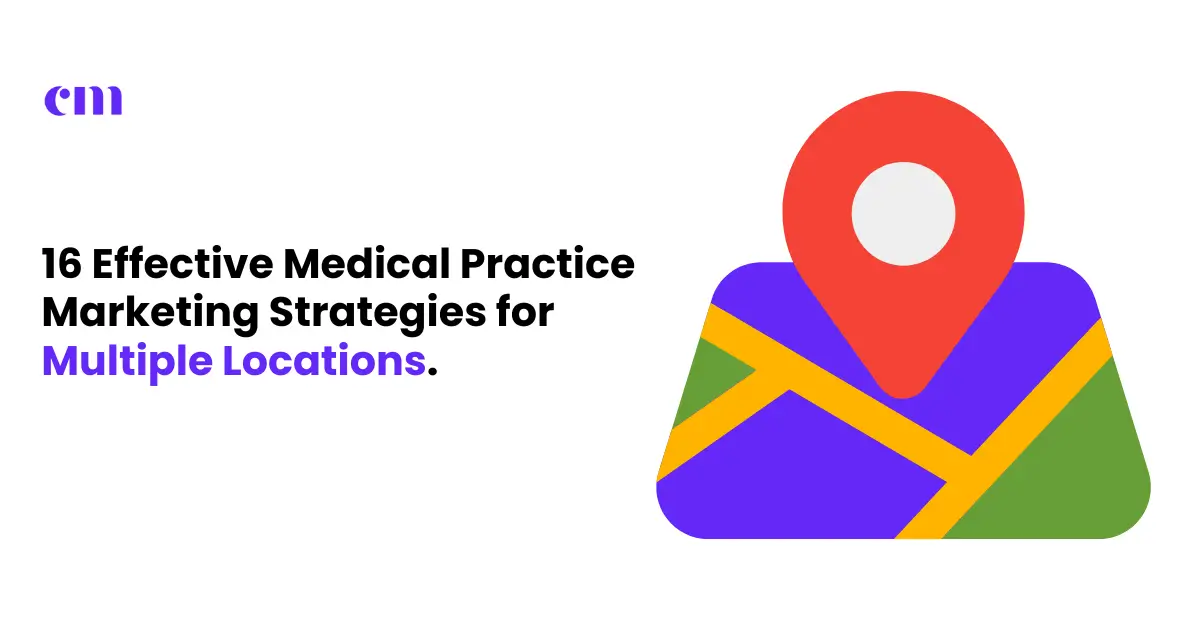In today’s competitive healthcare landscape, medical practice marketing with multiple locations can be a daunting task.
Contents
ToggleWhether you’re expanding your reach or already managing several sites, having a strategic approach can make all the difference.
To help you navigate the complexities of multi-location medical practice marketing, we’ve put together a comprehensive medical marketing guide covering essential strategies and best practices.
16 Effective Medical Practice Marketing Strategies for Multiple Locations
This guide will walk you through the effective and proven medical marketing strategies to ensure each location thrives.
So, let’s get into it and discover how to get more patients effectively in the market with multi-location medical practice.
Table of Contents:
1. Choose a Strong Group Practice Name
2. Maintain Consistent Branding
3. Decide on One Website or Multiple
4. Create Pages for Each Location
5. Clearly Display All Locations
6. Create Local Listings for Each Location
7. Create Local Listings for Each Doctor
8. Collect Reviews for Each Location
9. Create and Set Up Social Profiles Correctly
10. Post Unique Content for Each Location
11. Use Local Keywords
12. Set an Advertising Budget for Each Location
13. Define Advertising Boundaries
14. Track Leads by Location
15. Centralize Your Call Center
16. Automate Location-Specific Communications
1. Choose a Strong Group Practice Name
Your practice’s name is the foundation of your brand identity, and it’s crucial to choose wisely when operating multiple locations.
While it may be tempting to incorporate a specific geographic reference, such as “Pune Dermatology,” this approach can limit your ability to expand into new areas or regions in the future.
Instead, consider a more versatile name that reflects your specialty or core values, such as “Healthy Skin Solutions” or “Comprehensive Dermatology Associates.”
This will allow you to maintain brand consistency across all locations while leaving room for future growth.
2. Maintain Consistent Branding
Consistency is key when it comes to building a strong and recognizable brand for your multi-location medical practice.
From your logo and color palette to your messaging and tone of voice, every touchpoint should reinforce your brand identity.
Develop a comprehensive brand style guide that outlines your visual and messaging guidelines, and ensure that all marketing materials, websites, and online listings adhere to these standards.
This level of consistency will not only enhance brand recognition but also foster trust and credibility among your patients.
Also Read: Healthcare Branding in 2024: The Complete Guide.
3. Decide on One Website or Multiple
Decide whether to have a single website for your entire practice or individual sites for each location.
A unified website simplifies management and SEO efforts, while separate sites can cater more specifically to local audiences.
Pro Tip: If you choose a combined website, ensure each location has its dedicated page.
Moreover, this helps with Local SEO for medical practices and makes it easier for patients to find information relevant to their area.
4. Create Pages for Each Location
Regardless of whether you opt for a single or separate website, it’s essential to create dedicated pages for each of your practice locations.
These location-specific pages should include:
- Address and contact information
- Operating hours
- Staff bios and specialties
- Services offered at that specific location
- Directions and parking information
- Engaging visual content showcasing the facility
By providing this level of detail, you not only improve the user experience for patients but also increase the likelihood of ranking well in local search results for each respective location.
5. Clearly Display All Locations
When patients visit your website or online listings, it should be immediately clear which locations you operate and how to find the one most convenient for them.
Consider implementing location detection functionality, which automatically displays the nearest location based on the user’s IP address or geo-location data.
Tip: Use Google Maps integration for easy access and directions.
6. Create Local Listings for Each Location
Local listings, such as those on Google My Business, Bing Places, and industry-specific directories like Healthgrades, are crucial for establishing your online presence and visibility in local search results.
Ensure that you create and optimize GBP listings for each of your practice locations, complete with accurate name, address, and phone number (NAP) information, operating hours, and relevant categories.
Consistently managing and updating these listings can significantly improve your chances of appearing in the coveted “Local Pack” or “Map Pack” search results, which can drive more foot traffic and appointments to your nearby locations.
According to Google, businesses with verified GMB listings are twice as likely to be considered reputable.
7. Create Local Listings for Each Doctor
In addition to creating local listings for your practice locations, it’s also beneficial to establish individual listings for each healthcare provider within your group.
This approach can enhance online visibility for doctors and credibility, as patients often search for specific doctors by name or specialty.
Ensure that these individual listings are accurately linked to the corresponding practice location(s) and consistently maintain up-to-date information, including bios, areas of expertise, and patient reviews.
Yext stats show business listings get 2.7x more views than of a brand’s website (including local pages).
Also read: 9 SEO Strategies for Doctors: Attract More Patients Online.
8. Collect Reviews for Each Location
Online reviews play a crucial role in shaping patient perceptions and driving appointment bookings.
According to a survey by BrightLocal, 88% of consumers trust online reviews as much as personal recommendations from friends and family.
Implement a systematic approach to collecting and managing reviews for your entire group practice, as well as for individual providers and locations.
Encourage satisfied patients to leave reviews on popular platforms like Google, Healthgrades, and Practo, and promptly respond to both positive and negative feedback in a professional and empathetic manner.
9. Create and Set Up Social Profiles Correctly
Social media is a great way to connect with your community. Create individual profiles for each location or a single profile that clearly communicates the presence of multiple locations.
However, it’s essential to set up your social profiles correctly to ensure a cohesive and location-specific presence.
Consider creating individual social media pages or accounts for each practice location, allowing you to tailor your content and promotions to the local community.
Alternatively, you can maintain a central page for your group practice while leveraging location-tagging and geo-targeting features to reach specific audiences.
Strategy: Share location-specific updates, health tips, and patient stories to keep followers engaged.
10. Post Unique Content for Each Location
While maintaining a consistent brand voice and messaging across all locations is important, it’s equally crucial to tailor your content to the unique needs and interests of each local community.
Moreover, the personalized approach not only enhances engagement but also demonstrates your commitment to understanding and serving the specific healthcare needs of each area.
Consider creating location-specific blog posts, social media updates, and email campaigns that highlight local health concerns, community events, or even staff spotlights from that particular practice site.
11. Use Local Keywords
Search engine optimization (SEO) is a critical component of any effective digital marketing strategy, and for multi-location medical practices, it’s essential to localize your keyword research efforts.
While targeting broad, high-volume keywords related to your specialty is still important, you should also identify and optimize for location-specific keywords and phrases that potential patients in each area might use.
Tool: Use Google Keyword Planner or Ahrefs to find local search terms.
For example, a dermatology practice in Los Angeles might target “dermatologist in Los Angeles,” while a location in San Diego would focus on “dermatologist in San Diego.”
12. Set an Advertising Budget for Each Location
When it comes to paid advertising, such as Google Ads or social media campaigns, it’s crucial to allocate your budget strategically across your various practice locations.
Rather than a one-size-fits-all approach, consider establishing a per-location advertising budget based on factors such as:
- Population density and demographic makeup of each area
- Competition levels and cost-per-click (CPC) rates in each market
- Performance metrics and return on investment (ROI) for each location’s campaigns
13. Define Advertising Boundaries
Define clear geographic boundaries for your paid advertising campaigns.
Moreover, this ensures your ads are shown to the right audience in the right location, maximizing their effectiveness.
Action Step: Use geo-targeting features on platforms like Google Ads and Facebook Ads to refine your audience reach.
14. Track Leads by Location
Implement a system to track leads and patient inquiries separately for each location.
This allows you to assess the performance of your marketing efforts and make data-driven decisions.
Tool: Use a CRM system that supports multi-location tracking and reporting.
15. Centralize Your Call Center
A centralized call center can help streamline patient inquiries and appointment bookings.
Ensure the call center staff is well-trained and knowledgeable about each location’s services and availability.
This will provide a consistent experience for patients and improve efficiency.
16. Automate Location-Specific Communications
Automate your communications, such as appointment reminders and follow-up emails, but segment them by location.
This ensures patients receive relevant information specific to their site.
Tool: Use email marketing platforms like Mailchimp or HubSpot to set up automated workflows.
Conclusion
Marketing a medical practice with multiple locations involves careful planning and execution.
By considering your group practice name, maintaining brand consistency, creating dedicated pages for each location, and optimizing local listings, you can effectively reach and engage patients.
Moreover, utilizing local SEO, social media, and tailored content will further enhance your visibility and credibility.
Centralizing your call center and automating communications can improve patient experience and operational efficiency.
At Crawl Math, we specialize in healthcare digital marketing, providing tailored medical marketing strategies to help your multi-location practice thrive.
Contact us today to learn how we can help you elevate your marketing efforts and grow your patient base.


